Turkish Armed Forces
The Turkish Armed Forces (TAF; Turkish: Türk Silahlı Kuvvetleri, TSK) are the military forces of the Republic of Turkey. They consist of the Land Forces, the Naval Forces and the Air Forces. The current Chief of the General staff is General Yaşar Güler. The Chief of the General Staff is the Commander of the Armed Forces. In wartime, he acts as the Commander in Chief on behalf of the president, who represents the Supreme Military Command of the TAF on behalf of the Grand National Assembly of Turkey.[8] Commanding the Armed Forces is the responsibility of the General Staff, as well as coordinating the military relations of the TAF with other NATO member states and friendly states.
| Turkish Armed Forces | |
|---|---|
| Türk Silahlı Kuvvetleri | |
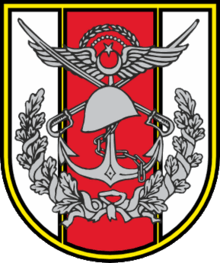 Emblem of the Turkish Armed Forces | |
| Founded | 209 BC (symbolic claim)[1] |
| Current form | May 3, 1920[lower-alpha 1] |
| Service branches | |
| Headquarters | Bakanlıklar, Çankaya, Ankara, Turkey |
| Leadership | |
| Commander-in-Chief | |
| Minister of National Defence | |
| Chief of the General Staff | |
| Manpower | |
| Military age | 21–41 |
| Conscription | 6 or 12 months depending on education level[2] |
| Active personnel | 355,200[3] |
| Reserve personnel | 380,000[3] |
| Expenditures | |
| Budget | US$20.4 billion (2019)[4] (ranked 16th) |
| Percent of GDP | 2.7% (2019)[4] |
| Industry | |
| Domestic suppliers | |
| Foreign suppliers | |
| Annual imports | $1,540 million (2014)[5] |
| Annual exports | $2,350 million (2018)[6] |
| Related articles | |
| History |
|
| Ranks | Military ranks of Turkey |
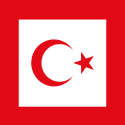 |
| Branches |
|---|
| History |
| Special forces |
| Member of |
| Current overseas deployments and missions[7] |
The modern history of the army began with its formation after the collapse of the Ottoman Empire. The Turkish military perceived itself as the guardian of Kemalism, the official state ideology, especially of its emphasis on secularism. It suppressed several Kurdish rebellions in Turkish Kurdistan in the 1920s and 1930s. After becoming a member of NATO in 1952, Turkey initiated a comprehensive modernization program for its armed forces and sent troops to fight in the Korean War. Since the early 1980s, it has fought in the ongoing Kurdish-Turkish conflict. Towards the end of the 1980s, a second restructuring process was initiated. The Turkish Armed Forces participate in an EU Battlegroup under the control of the European Council, the Italian-Romanian-Turkish Battlegroup. The TAF also contributes operational staff to the Eurocorps multinational army corps initiative of the EU and NATO.
The Turkish Armed Forces is the second largest standing military force in NATO, after the U.S. Armed Forces, with an estimated strength in 2015 of 639,551 military, civilian and paramilitary personnel.[9][10][11][12][13]
Turkey is one of five NATO member states which are part of the nuclear sharing policy of the alliance, together with Belgium, Germany, Italy, and the Netherlands.[14] A total of 90 B61 nuclear bombs are hosted at the Incirlik Air Base. 40 of these are allocated for use by the Turkish Air Force in case of a nuclear conflict, but their use requires the approval of NATO.[15]
History
War of Independence
After the end of World War I, many Ottoman military personnel escaped from Rumelia to Anatolia in order to join the new Turkish National Movement (TNM). During the War of Independence, on 3 May 1920, Birinci Ferik Mustafa Fevzi Pasha (Çakmak) was appointed the Minister of National Defence, and Mirliva İsmet Pasha (İnönü) was appointed the Minister of the Chief of General Staff of the government of the Grand National Assembly (GNA).[16] But on 3 August 1921, the GNA fired İsmet Pasha from the post of Minister of National Defence because of his failure at the Battle of Afyonkarahisar–Eskişehir and on 5 August, just before the Battle of Sakarya, appointed the chairman of the GNA Mustafa Kemal Pasha (Atatürk) as commander-in-chief of the Army of the GNA. The TNM won the War of Independence in 1922.
First Kurdish rebellions
There were several Kurdish rebellions in Turkish Kurdistan in the 1920s and 1930s, the most important of which were the 1925 Sheikh Said rebellion and the 1937 Dersim rebellion. All were suppressed by the TAF, sometimes involving large-scale mobilisations of up to 50,000 troops. Associated atrocities against civilians include the Zilan massacre.
World War II
Turkey remained neutral until the final stages of World War II. In the initial stage of World War II, Turkey signed a treaty of mutual assistance with Great Britain and France.[17] But after the fall of France, the Turkish government tried to maintain an equal distance with both the Allies and the Axis. Following Nazi Germany's occupation of the Balkans, upon which the Axis-controlled territory in Thrace and the eastern islands of the Aegean Sea bordered Turkey, the Turkish government signed a Treaty of Friendship and Non-Aggression with Germany on 18 June 1941.
After the German invasion of the Soviet Union, the Turkish government sent a military delegation of observers under Lieutenant General Ali Fuat Erden to Germany and the Eastern Front.[18] After the German retreat from the Caucasus, the Turkish government moved closer to the Allies and Winston Churchill secretly met with İsmet İnönü at the Adana Conference in Yenice Train Station in southern Turkey on 30 January 1943, with the intent of persuading Turkey to join the war on the side of the Allies. A few days before the start of Operation Zitadelle in July 1943, the Turkish government sent a military delegation under General Cemil Cahit Toydemir to Russia and observed the exercises of the 503rd Heavy Panzer Battalion and its equipment.[19] But after the failure of Operation Zitadelle, the Turkish government participated in the Second Cairo Conference in December 1943, where Franklin D. Roosevelt, Churchill and İnönü reached an agreement on issues regarding Turkey's possible contribution to the Allies. On 23 February 1945, Turkey joined the Allies by declaring war against Germany and Japan, after it was announced at the Yalta Conference that only the states which were formally at war with Germany and Japan by 1 March 1945 would be admitted to the United Nations.[20]
Korean War
Turkey participated in the Korean War as a member state of the United Nations and sent the Turkish Brigade, which suffered 731 losses in combat, to South Korea. On 18 February 1952, Turkey became a member of NATO.[21] The South Korean government donated a war memorial for the Turkish soldiers who fought and died in Korea. The Korean pagoda is in Ankara and it was donated in 1973 for the 50th anniversary of the Turkish Republic.
Invasion in Cyprus
On 20 July 1974, the TAF launched an amphibious and airborne assault operation on Cyprus, in response to the 1974 Cypriot coup d'état which had been staged by EOKA-B and the Cypriot National Guard against president Makarios III with the intention of annexing the island to Greece; but the military intervention ended up with Turkey occupying a considerable area on the northern part of Cyprus and helping to establish a local government of Turkish Cypriots there, which has thus far been recognized only by Turkey. The intervention came after more than a decade of intercommunal violence (1963–1974) between the island's Greek Cypriots and Turkish Cypriots, resulting from the constitutional breakdown of 1963. Turkey invoked its role as a guarantor under the Treaty of Guarantee in justification for the military intervention.[22] Turkish forces landed on the island in two waves, invading and occupying 37% of the island's territory in the northeast for the Turkish Cypriots, who had been isolated in small enclaves across the island prior to the military intervention.[23][24][25]
In the aftermath, the Turkish Cypriots declared a separate political entity in the form of the Turkish Federated State of Cyprus in 1975; and in 1983 made a unilateral declaration of independence as the Turkish Republic of Northern Cyprus, which was recognized only by Turkey. The United Nations continues to recognize the sovereignty of the Republic of Cyprus according to the terms of its independence in 1960. The conflict continues to overshadow Turkish relations with Greece and with the European Union. In 2004, during the referendum for the Annan Plan for Cyprus (a United Nations proposal to resolve the Cyprus dispute) 76% of the Greek Cypriots rejected the proposal, while 65% of the Turkish Cypriots accepted it.
Kurdish–Turkish conflict
The TAF have fought for decades in the Kurdish-Turkish conflict, mostly against the Kurdistan Workers' Party (PKK).[26][27][28][29][30] While most of the conflict has taken place in Turkish Kurdistan, it has also involved forays into neighbouring Iraqi Kurdistan as well as more recent attacks on the PKK-affiliated Syrian Democratic Forces in Rojava. The conflict reignited in 2015, after the failure of a three-year Kurdish-Turkish peace process.[31]
War in Bosnia and Kosovo
Turkey contributed troops in several NATO-led peace forces in Bosnia and Kosovo. Currently there are 402 Turkish troops in Kosovo Force.
War in Afghanistan
After the 2003 Istanbul Bombings were linked to Al-Qaeda, Turkey deployed troops to Afghanistan to fight Taliban forces and Al-Qaeda operatives, with the hopes of dismantling both groups. Turkey's responsibilities include providing security in Kabul (it currently leads Regional Command Capital), as well as in Wardak Province, where it leads PRT Maidan Shahr. Turkey was once the third largest contingent within the International Security Assistance Force. Turkey's troops are not engaged in combat operations and Ankara has long resisted pressure from Washington to offer more combat troops. According to the Washington Post, in December 2009, after US President Barack Obama announced he would deploy 30,000 more U.S. soldiers, and that Washington wants others to follow suit, Turkish Prime Minister Recep Tayyip Erdoğan reacted with the message that Turkey would not contribute additional troops to Afghanistan. "Turkey has already done what it can do by boosting its contingent of soldiers there to 1,750 from around 700 without being asked", said Erdoğan, who stressed that Turkey would continue its training of Afghan security forces.
Humanitarian relief
The TAF have performed "Disaster Relief Operations," as in the 1999 İzmit earthquake in the Marmara Region of Turkey. Apart from contributing to NATO, the Turkish Navy also contributes to the Black Sea Naval Co-operation Task Group, which was created in early 2001 by Turkey, Bulgaria, Georgia, Romania, Russia and Ukraine for search and rescue and other humanitarian operations in the Black Sea.
Today
According to the International Institute for Strategic Studies (IISS), in 2010 the Turkish Armed Forces had an active strength of around 402,000 active personnel, consisting of 77,000 professionals and 325,000 conscripts. In addition, it was estimated that there were 378,700 reserve personnel and 152,200 paramilitary personnel (Turkish Gendarmerie and Turkish Coast Guard), giving a combined active and reserve strength of around 932,900 personnel.[32] In 2010, the defence budget amounted to 26 billion liras.[33] The Law on the Court of Accounts was supposed to initiate external ex-post audits of armed forces' expenditure and pave the way for audits of extra budgetary resources earmarked for the defence sector, including the Defence Industry Support Fund.[34] However, the Ministry of Defense has not provided the necessary information,[35] so the armed forces expenditure is not being properly checked.
In 1998, Turkey announced a programme of modernisation worth US$160 billion over a twenty-year period in various projects including tanks, fighter jets, helicopters, submarines, warships and assault rifles.[36] Turkey is a Level 3 contributor to the Joint Strike Fighter (JSF) programme.[37] The final goal of Turkey is to produce new-generation indigenous military equipment and to become increasingly self-sufficient in terms of military technologies.
Havelsan of Turkey and Boeing of the United States are in the process of developing a next-generation, high-altitude ballistic missile defence shield. Turkey has chosen the Chinese defense firm CPMIEC to co-produce a $4 billion long-range air and missile system.
| Date | General/Admiral | Officer | Total (incl. civilian) |
|---|---|---|---|
| 21 Nov 2011[38] | 365 | 39,975 | 666,576 |
| 2 Oct 2013[39] | 347 | 39,451 | 647,583 |
| 2 May 2014[40] | 343 | 38,971 | 623,101 |
General staff
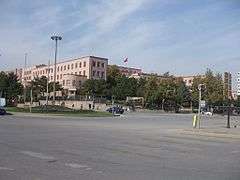
The General Staff of the Republic of Turkey presides over the Armed Forces of the Republic of Turkey, comprising the Army, Navy and Air Force. The General Command of the Gendarmerie and the Coast Guard, which operate as parts of the internal security forces in peacetime, are subordinate to the Army and Navy Commands, respectively, in wartime, and both have law enforcement and military functions.
Also, the General Staff is in command of the Special Forces, which is not aligned to any force command within the TAF. The Maroon Berets get their orders directly from the General Staff of the Republic of Turkey.[41]
Land Forces
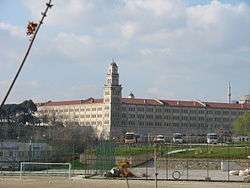
The Turkish Land Forces, or Turkish Army, can trace its origins in the remnants of Ottoman forces during the fall of the Ottoman Empire at the end of World War I. When Mustafa Kemal Atatürk and his colleagues formed the Grand National Assembly (GNA) in Ankara on 23 April 1920, the XV Corps under the command of Kâzım Karabekir was the only corps which had any combat value.[42] On 8 November 1920, the GNA decided to establish a standing army (Düzenli ordu) instead of irregular troops (the Kuva-yi Milliye, Kuva-yi Seyyare, etc.)[43] The army of the government of the GNA won the Turkish War of Independence in 1922.
As of 2006, the Turkish Army had 1,300 troops deployed in northern Iraq, according to documents released as part of the United States diplomatic cables leak.[44] The Turkish Army also maintains around 17,500 troops in Northern Cyprus, as part of the Cyprus Turkish Peace Force (Kıbrıs Türk Barış Kuvvetleri, or KTBK.)[45]
Naval Forces

The Turkish Naval Forces, or Turkish Navy, constitutes the naval warfare service branch of the Turkish Armed Forces. The Turkish Navy maintains several Marines and Special Operations units. The Amphibious Marines Brigade (Amfibi Deniz Piyade Tugayı) based in Foça near İzmir consists of 4,500 men, three amphibious battalions, an MBT battalion, an artillery battalion, a support battalion and other company-sized units.[46] The Su Altı Taarruz (S.A.T. – Underwater Attack) is dedicated to missions including the acquisition of military intelligence, amphibious assault, counter-terrorism and VIP protection; while the Su Altı Savunma (S.A.S. – Underwater Defense) is dedicated to coastal defense operations (such as clearing mines or unexploded torpedoes) and disabling enemy vessels or weapons with underwater operations; as well as counter-terrorism and VIP protection missions.[46]
Air Force
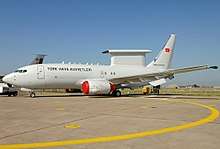
The Turkish Air Force is the aerial warfare service branch of the Turkish Armed Forces. It is primarily responsible for the protection and sovereignty of Turkish airspace but also provides air-power to the other service branches. Turkey is one of five NATO member states which are part of the nuclear sharing policy of the alliance, together with Belgium, Germany, Italy, and the Netherlands.[47] A total of 90 B61 nuclear bombs are hosted at the Incirlik Air Base, 40 of which are allocated for use by the Turkish Air Force in case of a nuclear conflict, but their use requires the approval of NATO.[48]
The Air Force took part in the Operation Deliberate Force of 1995 and Operation Allied Force of 1999, and later participated in the United Nations peacekeeping mission in Bosnia-Herzegovina, employing two squadrons (one in the Ghedi fighter wing, and after 2000 one in the Aviano fighter wing.)[49] They returned to Turkey in 2001. In 2006, 4 Turkish F-16 fighter jets were deployed for NATO's Baltic Air Policing operation.
Turkish War Academies
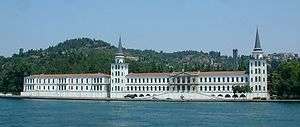
Turkish War Academies constitute the educational branch of the Turkish Armed Forces. The Ottoman Military College, which later evolved into the Turkish Army War College, was established in 1848. The Naval War College was established in 1864, and the Air War College was established in 1937 (the Aircraft School (Tayyare Mektebi) of the Ottoman Aviation Squadrons was established in 1912, and the Naval Aircraft School (Bahriye Tayyare Mektebi) was established in 1914.)
In order to train Staff Officers in the same system as European armies, the 3rd and 4th years were created in the Army War Academy under the name of "Imperial War School of Military Sciences, General Staff Courses" in 1848. As part of the reorganization efforts of the Ottoman Army, new arrangements were implemented in 1866 for the Staff College and other Military Schools. Through these arrangements, the General Staff training was extended to three years, and with additional military courses a special emphasis was placed on exercises and hands-on training. Although being a staff officer was initially considered a different military branch in itself, effective from 1867 new programs were implemented to train staff officers for branches such as the infantry, cavalry and artillery. In 1899, a new system was developed on the basis of the view that the General Staff Courses should train more officers with higher military education in addition to Staff Officers’ training. Following this principle, a greater number of officers from the Army War Academy began to be admitted to the Staff College. This process continued until 1908. Following the declaration of the Second Constitutional Era in 1908, the structure of the Staff College was rearranged with a new Staff College Regulation on 4 August 1909. A couple of months later, in October, the College was moved from Harbiye to the Yıldız Palace, Crown Prices’ Quarter with the new designation "General Staff School". With this fundamental change, the practice of direct transition from Army War Academy to Staff College was abolished, and admission into Staff College now required two years of field service following the Army War Academy. Afterwards, the officers were subjected to examinations, and those who passed the exam were admitted into the College as Staff Officer candidates. Following the occupation of Istanbul by the Allies of World War I on 16 March 1920, Ottoman military schools were dissolved by the victors of the First World War; nevertheless, the Staff College managed to continue its activities until April 1921 at the Şerif Pasha Mansion in Teşvikiye, Istanbul, where it was relocated on 28 January 1919. In early 1921, it was decided that the Staff College should be moved to Beylerbeyi, Istanbul. However, since all instructors and students had gone to Anatolia to join the Turkish War of Independence, the Staff College was closed down temporarily.
On 13 October 1923, shortly before the proclamation of the Republic of Turkey on 29 October, the Staff College restarted its education and training activities under the name of "Higher Military College" in Beyazıt, Istanbul, in the building of the Ministry of War, today used as the rectorate building of Istanbul University. About six months later, on 24 March 1924, the College was renamed the "Directorate of the General Staff College" and moved to the Yıldız Palace. In 1927, it was once more renamed as the "Staff College Directorate". The College continued its education and training activities in this location until 1975. The War Colleges Command was formed in March 1949. The National Security College was founded in 1952 and the Armed Forces College was established in 1954. The National Security College moved to Ankara in 1995, and by moving back to Istanbul in 2012, it was merged with the Armed Forces College, and since then has been continuing its education and training activities as the Armed Forces Higher Command and Control College.
- Ottoman Ministry of War in Istanbul, currently the Rectorate building of Istanbul University
- Taşkışla Barracks in Istanbul, currently the Taşkışla Campus of Istanbul Technical University
- Maçka Barracks in Istanbul, currently the Maçka Campus of Istanbul Technical University
Military bases abroad
As of August 2013, Turkey has a total of 3,189 military personnel outside its territory. The only military base stationed permanently abroad, regardless of the organizations that are members of Turkey, which has been temporarily holding troops several times abroad due to its responsibilities arising from many international political members, particularly NATO membership, is the Cyprus Turkish Peace Force Command. The military bases of Turkish Armed Forces in Qatar, Syria,[50] Somalia[51] and Bashiqa are active. It is announced that in 2017 Turkey will start working to establish a research base in Antarctica.[52]
Role of the military in Turkish politics
After the Republic of Turkey was founded in 1923, Mustafa Kemal Atatürk prohibited the political activities of officers in active service with the Military Penal Code numbered 1632 and dated 22 May 1930 (Askeri Ceza Kanunu).[53] However, after the coups d'état in 1960, the Millî Birlik Komitesi (National Unity Committee) established the Inner Service Act of the Turkish Armed Forces (Türk Silahlı Kuvvetleri İç Hizmet Kanunu) on 4 January 1961 to legitimize their military interventions in politics. In subsequent coup d'états and coup d'état attempts, they showed reasons to justify their political activities especially with the article 35 and 85 of this act.[54]
The Turkish military perceived itself as the guardian of Kemalist ideology, the official state ideology, especially of the secular aspects of Kemalism. The TAF still maintains an important degree of influence over the decision making process regarding issues related to Turkish national security, albeit decreased in the past decades, via the National Security Council.
The military had a record of intervening in politics, removing elected governments four times in the past. Indeed, it assumed power for several periods in the latter half of the 20th century. It executed three coups d'état: in 1960 (May 27 coup), in 1971 (March 12 coup), and in 1980 (September 12 coup). Following the 1960 coup d'état, the military executed the first democratically elected prime minister in Turkey, Adnan Menderes, in 1961.[55] Most recently, it maneuvered the removal of an Islamist prime minister, Necmettin Erbakan, in 1997 (known as the February 28 memorandum).[56] Contrary to outsider expectations, the Turkish populace was not uniformly averse to coups; many welcomed the ejection of governments they perceived as unconstitutional.[57]
On 27 April 2007, in advance of the 4 November 2007 presidential election, and in reaction to the politics of Abdullah Gül, who has a past record of involvement in Islamist political movements and banned Islamist parties such as the Welfare Party, the army issued a statement of its interests. It said that the army is a party to "arguments" regarding secularism; that Islamism ran counter to the secular nature of Turkey, and to the legacy of Mustafa Kemal Atatürk. The Army's statement ended with a clear warning that the TAF stood ready to intervene if the secular nature of the Turkish Constitution is compromised, stating that "the Turkish Armed Forces maintain their sound determination to carry out their duties stemming from laws to protect the unchangeable characteristics of the Republic of Turkey. Their loyalty to this determination is absolute."[58]
Over a hundred people, including several generals, have been detained or questioned since July 2008 with respect to so-called organisation Ergenekon, an alleged clandestine, ultra-nationalist organization with ties to members of the country's military and security forces. The group is accused of terrorism in Turkey. These accusing claims are reported, even while the trials are going on, mostly in the counter-secular and Islamist media organs.
On 22 February 2010 more than 40 officers were arrested and then formally charged with attempting to overthrow the government with respect to so-called "Sledgehammer" plot. They include four admirals, a general and two colonels, some of them retired, including former commanders of the Turkish navy and air force (three days later, the former commanders of the navy and air force were released). Partially as a result, the Washington Post reported in April 2010 that the military's power had decreased.[59]
On the eve of the Supreme Military Council of August 2011, the Chief of the General Staff, along with the Army, Navy, and Air Force commanders, requested their retirement, in protest of the mass arrests which they perceived as a deliberate and planned attack against the Kemalist and secular-minded officers of the Turkish Armed Forces by the Islamists in Turkey, who began to control key positions in the Turkish government, judiciary and police.[60][61][62] The swift replacement of the force commanders in the Supreme Military Council meeting affirmed the government's control over the appointment of top-level commanders. However, promotions continue to be determined by the General Staff with limited civilian control. The European Commission, in its 2011 regular yearly report on Turkey's progress towards EU accession, stated that "further reforms on the composition and powers of the Supreme Military Council, particularly on the legal basis of promotions, still need to materialise."[63] The service branch commanders continue to report to the Prime Minister instead of the Defence Minister.
In July 2016, a few rogue factions of the Turkish Armed Forces attempted to take over the government, but Erdogan supporters and other loyal military units stopped the coup attempt.[64] Many lives were lost and hundreds were injured. The parliament house and some other buildings in Ankara and Istanbul were damaged. Thousands of military personnel have been arrested and structure of the armed forces has been overhauled.[64]
Medals and awards
- Turkish Armed Forces Medal of Honor
- Turkish Armed Forces Medal of Distinguished Service
- Turkish Armed Forces Medal of Distinguished Courage and Self-Sacrifice
- Turkish Armed Forces Medal of Bravery and Valour
- Turkish Armed Forces State Medal of Honor
See also
- Village guard system
- Conscription in Turkey
- List of Chiefs of the Turkish General Staff
- Military equipment of Turkey
- 2016 Turkish coup d'état attempt
Notes
- As the Army of the Grand National Assembly.[1]
References
- "TSK Official History Information". Turkish Armed Forces. Turkish Armed Forces. Archived from the original on 29 June 2013. Retrieved 2 January 2014.
- https://ahvalnews.com/turkish-military/can-turkey-build-21st-century-army
- IISS 2018, pp. 156-157
- Tian, Nan; Fleurant, Aude; Kuimova, Alexandra; Wezeman, Pieter D.; Wezeman, Siemon T. (27 April 2020). "Trends in World Military Expenditure, 2019" (PDF). Stockholm International Peace Research Institute. Retrieved 27 April 2020.
- "Türkiye'nin ihracatı arttı ithalatı azaldı". TRT News. Archived from the original on 3 December 2015. Retrieved 30 November 2015.
- Archived 6 January 2019 at the Wayback Machine Savunma sanayisi ihracat rekorlarıyla eşik atladı
- "Türk Silahlı Kuvvetlerinin Barışı Destekleme Harekâtlarına Katkıları". tsk.tr. Retrieved 18 June 2014.
- Federal Research Division, Turkey: A Country Study, Kessinger Publishing, 2004, ISBN 978-1-4191-9126-8, p. 337.
- "News From Turkish Armed Forces". Turkish Armed Forces. tsk.tr. Archived from the original on 5 November 2015. Retrieved 5 November 2015.
- IISS 2010, pages 164–168
- defence.gov.au Archived 22 December 2015 at the Wayback Machine TURKEY – DEFENCE MARKET PROFILE, 2012
- Turkish Armed Forces Personnel Archived 2014-02-08 at the Wayback Machine 2014, Official Turkish Armed Forces website (In Turkish)
- "TSK Mevcut Personel Sayısını açıkladı". Turkish Armed Forces. Aktif Haber. Archived from the original on 6 October 2014. Retrieved 2 October 2014.
- "Der Spiegel: Foreign Minister Wants US Nukes out of Germany (10 April 2009)". Der Spiegel. 30 March 2009. Archived from the original on 14 February 2012. Retrieved 1 November 2010.
- Hans M. Kristensen. "NRDC: U.S. Nuclear Weapons in Europe" (PDF). Natural Resources Defense Council, 2005. Archived (PDF) from the original on 11 December 2015. Retrieved 1 November 2010.
- Harp Akademileri Komutanlığı, Harp Akademilerinin 120 Yılı, İstanbul, 1968, p. 26, 46.
- See Murat Metin Hakki, "Suriving the Pressure of the Superpowers: An Analysis of Turkish Neutrality During the Second World War Archived 3 March 2016 at the Wayback Machine", Chronicon 3 (1999–2007) 44 – 62, Center for Middle Eastern Studies, Harvard University, ISSN 1393-5259
- Hüseyin Hüsnü Emir Erkilet, Şark cephesinde gördüklerim, Hilmi Kitabevi, 1943.
- Johannes Glasneck, Inge Kircheisen, Türkei und Afghanistan, Dt. V. d. Wissenschaften, 1968, p. 139. Archived 2 May 2016 at the Wayback Machine
- Mustafa Aydın, SAM, "Turkish Foreign Policy: Framework and Analysis", Center for Strategic Research, 2004, p. 47.
- For some of the NATO command structure discussions re entry of Turkey, see Sean Maloney, Securing Command of the Sea, Masters' thesis, University of New Brunswick, 1992
- "From Rep. of Turkey Ministry of Foreign Affairs". Archived from the original on 16 July 2016. Retrieved 17 July 2016.
- Welz, Gisela (2006). Divided Cyprus: Modernity, History, and an Island in Conflict. Indiana University Press. p. 2. ISBN 0-253-21851-9.
- Carpenter, Ted Galen (2000). NATO's Empty Victory: A Postmortem on the Balkan War. Washington, D.C: Cato Institute. p. 36. ISBN 1-882577-85-X.
- Carpenter, Ted Galen (2002). Peace and Freedom: Foreign Policy for a Constitutional Republic. Washington, D.C: Cato Institute. p. 187. ISBN 1-930865-34-1.
- "People's Daily Online – NATO chief declares PKK terrorist group". Archived from the original on 19 October 2014. Retrieved 17 July 2016.
- "The EU's list of terrorist groups". Archived from the original on 1 December 2011.
- "Council Decision 2011/70/CFSP of 31 January 2011 updating the list of persons, groups and entities subject to Articles 2, 3 and 4 of Common Position 2001/931/CFSP on the application of specific measures to combat terrorism – Official Journal L 028, 02/02/2011 P. 0057 – 0059". Archived from the original on 22 November 2011. Retrieved 12 June 2012.
- "NATO chief declares PKK terrorist group". Xinhua. 20 December 2005. Archived from the original on 19 October 2014. Retrieved 12 June 2012.
- European Union List of Terrorist Organisations Archived 22 November 2011 at the Wayback Machine, Council of the european union, updated Council Decision 2011/70/CFSP of 31 January 2011
- "KCK ateşkesin bittiğini açıkladı: Bundan sonra tüm barajlar gerillanın hedefinde olacaktır". t24.com.tr (in Turkish). Archived from the original on 22 March 2017. Retrieved 30 March 2017.
- IISS 2010, pp. 164–168
- "SIPRI Publications". Milexdata.sipri.org. Archived from the original on 3 May 2012. Retrieved 23 October 2011.
- "Archived copy" (PDF). Archived (PDF) from the original on 27 October 2011. Retrieved 13 October 2011.CS1 maint: archived copy as title (link)
- "Lack of comprehensive audits casts shadow over security spending". Zaman. Archived from the original on 3 November 2013.
- Economist Intelligence Unit:Turkey, p.22 (2005)
- US Department of Defense (11 July 2002). "DoD, Turkey sign Joint Strike Fighter Agreement". US Department of Defense. Archived from the original on 23 December 2006. Retrieved 27 December 2006.
- "Asker sayısı ilk kez açıklandı". Ntvmsnbc. Retrieved 3 May 2014.
- "TSK personel sayısını açıkladı". Ntvmsnbc. Archived from the original on 3 May 2014. Retrieved 3 May 2014.
- "TSK personel sayısını açıkladı". Ntvmsnbc. Archived from the original on 3 May 2014. Retrieved 3 May 2014.
- Onlar TSK'nın bel kemiği – Sabah – HaberPlus – Gündem – 09 Aralık 2013 Archived 6 October 2015 at the Wayback Machine. Sabah (26 October 2011). Retrieved on 9 December 2013.
- Sina Akşin, Essays in Ottoman-Turkish Political History, Isis Press, 2000, p. 44.
- Suat İlhan, Atatürk ve Askerlik: Düşünce ve Uygulamaları, Atatürk Araştırma Merkezi, 1990, p. 88. Archived 10 January 2016 at the Wayback Machine (in Turkish)
- "paragraph 10". Wikileaks.ch. Archived from the original on 21 July 2011. Retrieved 23 October 2011.
- "U.S. Library of Congress: "Cyprus: Forces in the Turkish-Administered Area"". Archived from the original on 13 March 2013. Retrieved 8 May 2020.
- Ray Bonds, David Miller, Illustrated Directory of Special Forces, Zenith Imprint, 2003, p. 99. Archived 19 October 2017 at the Wayback Machine
- "Yankee Bombs Go Home: Foreign Minister Wants US Nukes out of Germany". 10 April 2009. Archived from the original on 28 August 2019. Retrieved 18 September 2019 – via Spiegel Online.
- "NRDC: U.S. Nuclear Weapons in Europe • Hans M. Kristensen / Natural Resources Defense Council, 2005" (PDF). Archived (PDF) from the original on 11 December 2015. Retrieved 28 December 2011.
- "1980-today in the official website of the Turkish Air Force". Archived from the original on 11 January 2012.
- "'Al-Sharq Al-Awsat' Report Specifies Locations of Foreign Military Bases in Syria, Says Syria Is Turning into Brittle Federation That Can Fall Apart at Any Moment". MEMRI – The Middle East Media Research Institute. Retrieved 30 March 2017.
- Tufan Aktas (13 October 2016). "Details emerge of Turkish military base in Somalia". Anadolu Agency. Archived from the original on 7 March 2017. Retrieved 7 March 2017.
- "Turkey plans to set up first research base in Antarctica". Daily Sabah. 10 February 2017. Archived from the original on 7 March 2017. Retrieved 7 March 2017.
- Askeri Ceza Kanunu Archived 15 May 2011 at the Wayback Machine, Ministry of Justice of the Republic of Turkey, 22 May 1930.
- Fikret Bila, "Çare ihtilal değil, komutanın konuşması" Archived 19 October 2012 at the Wayback Machine, Milliyet, 4 Oct 2007.
- Tuysuz, Gul; Tavernise, Sabrina (29 July 2011). "Top Generals Quit in Group, Stunning Turks". nytimes.com. New York Times. Archived from the original on 12 December 2016. Retrieved 28 February 2017.
- "The World Factbook – Turkey". Central Intelligence Agency. Archived from the original on 20 September 2017. Retrieved 28 October 2010.
- Lt. Col. Patrick F. Gillis (3 May 2004). "U.S.-Turkish Relations: The Road to Improving a Troubled Strategic Partnership" (PDF). U.S. Army War College. p. 4.
In all of these 'coups' the majority of the Turkish public accepted the military's actions because they felt they were necessary for the well being of the state and because the military did not seek to impose permanent military governance
- "Excerpts of Turkish army statement". BBC News. 28 April 2007. Archived from the original on 8 April 2008. Retrieved 30 June 2008.
- Zacharia, Janine (11 April 2010). "In Turkey, military's power over secular democracy slips". The Washington Post. Archived from the original on 14 October 2017. Retrieved 30 October 2017.
- "Turkey: Military chiefs resign en masse – BBC News". BBC News. 29 July 2011. Archived from the original on 16 July 2016. Retrieved 17 July 2016.
- "Top Generals Quit in Group, Stunning Turks". The New York Times. 30 July 2011. Archived from the original on 16 July 2016. Retrieved 17 July 2016.
- Letsch, Constanze (30 July 2011). "Turkey military chiefs resign over Sledgehammer 'coup plot' arrests". The Guardian. Archived from the original on 16 July 2016. Retrieved 17 July 2016.
- "page 14" (PDF). Archived (PDF) from the original on 27 October 2011.
- "Turkey's opposition parties take unified stance against coup attempt". Daily Sabah. 16 July 2016.
Bibliography
- International Institute for Strategic Studies (14 February 2018). The Military Balance 2018. London: Routledge. ISBN 9781857439557.
- International Institute for Strategic Studies; Hackett, James (ed.) (3 February 2010). The Military Balance 2010. London: Routledge. ISBN 978-1-85743-557-3.CS1 maint: extra text: authors list (link)
- Birler, Hayri (7 February 1997). "The Coup Primer". Turkish Daily News. Archived from the original on 13 August 2011. Retrieved 12 October 2008.
- Gareth Jenkins, 'Power and unaccountability in the Turkish security forces,' Conflict, Security, and Development, Volume 1, Issue 1.
External links
| Wikimedia Commons has media related to Military of Turkey. |
- Turkish Armed Forces (English)
- Bosphorus Naval News (turkishnavy.net)